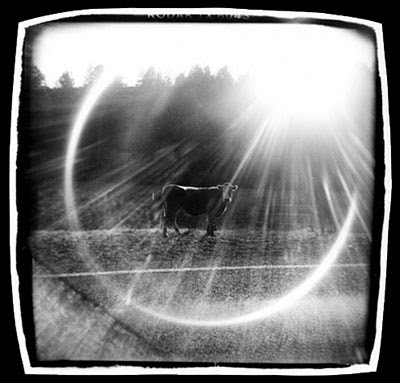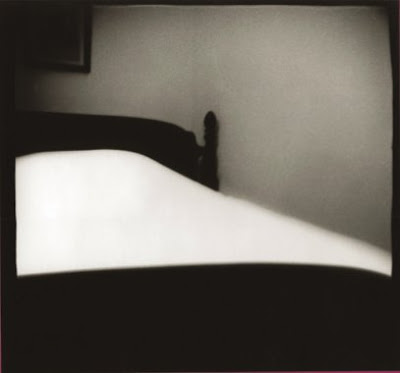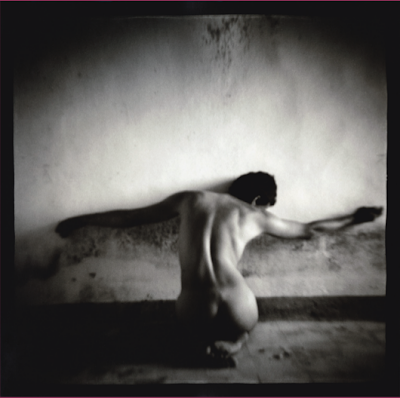
Holy Cow (Michelle Bates) Camera: Holga
Some people prefer a blurry image full of lens aberrations to a focused one. What makes a "toy" image a good image?
I think I good image is a good image, regardless of the camera that is used. Sometimes it is difficult to move past the "gimmicky" effects of a toy camera. When someone first starts using one, they may fall in love with the effects - the blur, the aberrations, the flare, etc - but it takes a talented photographer to create images that come from their own artistic vision, and not just what the camera does. For an image to be a good toy camera image, it incorporates the photographer's eye and the look of the camera.

A Woman's Bed (Nancy Rexroth, 1970) Camera: Diana
Is it possible to make serious work with toy cameras?
Yes! My passion has always been to find people who are making serious work with these cameras; my book is proof of this - there are 49 photographers making beautiful, well-crafted photographs, as part of series of fine art images, or for magazines, newspapers or commercial clients.
One of the laws of Lomographers is: "Don't think, just shoot". Does this kind of photography needs some preparation?
There are different ways of using these cameras. You can go out and shoot without thinking. That can be fun, but I've also seen people get frustrated with their results, especially if they are used to digital cameras, which give them good results without their having to understand the camera. To get good results, you have to know the few elements of the camera, but it's even more important to understand the principles of photography: how light interacts with film, how to measure light and control the amount that gets into the camera, composition...

Hugging Wall, Italy (Anne Arden McDonald, 2000) Camera Diana, B mode.
Lomography: plastic cameras as a business. Do you prefer this kind of camera or the old ones? Some people argue that Lomography cameras are expensive, bad quality items...
The old Diana cameras (and clones) were simple, rather poorly made cameras, but photographers loved them. If people still have them or can find them, that's wonderful. Currently there are many cameras made, my favorite being the Holga. Holgas are made in China by Holga Ltd, and are actually pretty good quality, for a plastic camera, and are still very cheap. Some of the Lomographic products (they make the Diana+, the Diana Mini, several multi-lens cameras and accessories) are good quality, and some are not well-made. They are quite expensive, but they also have made these cameras available to a much wider audience than they were before. Having the cameras cost so much takes away one element that is attractive about toy cameras, but there are cheap options, and the effects and capabilities of the more expensive ones are worth it to some people.
Is there a risk for this kind of photograph to become a banal fashion?
Yes, there is. When people just shoot "Holga photos" as opposed to their own photos, then all the images look the same, and you can't tell who took them. If you look on Flickr, where there are probably millions of toy camera photos now, the majority look like the camera took them, not the photographer. In the hands of a talented photographer though, imagery will never be banal.

Lights of Freemont, Golden Nugget (Susan Bowen, 2005) Camera: Holga
Digital camera pros:
1.- Tons of photographs,
2.- Shooting is free
3.- You can manipulate them easily
Tell me about the cons...
Responding to those "pros":
1. Too many photographs! We tend to shoot more and think less with digital, and I think learn less. There is also the anticipation of waiting to see the images later which has a certain magic I miss with digital.
2. Shooting isn't free. With film cameras, you can use one camera for your entire career - a Leica will always work. With digital we get a new camera every 2 years, and they are not cheap. We also must continue to upgrade our computers, software and printers and buy more hard drives to store image files. In addition, we pay a price in time for always having to learn how to use the new cameras and software. With film cameras and the darkroom, we can learn one process, and spend our time getting better at it, as opposed to learning how to use our new equipment and software constantly.
3. There are many ways to manipulate images in the darkroom. But also, if you shoot film in a toy camera, you can scan the negatives and use all the digital tools to improve your images, and make digital prints.

After the fire (Michelle Bates) Camera: Mamiya 645
As a photographer, what kind of issues do you prefer to shoot?
I have photographed many subjects over the years. I like quirky subjects, like carnivals and animals, and these also tend to work well with the Holga. But, I also like to push the boundaries and try new subjects with the Holga, and so have series of nature images, portraits, cityscapes and many other things. Outside of my fine-art work, I also photograph theater and performers, usually also with a quirky element, including circus, vaudeville, puppetry and physical theater. This is now mostly digital. I also do some portraiture, and have done series of fire art & performance, and a series taken in the house of a friend that suffered from a fire.
There are a lot of books about cameras, lenses, Photoshop, studio techniques... fewer ones about training your eye. What is more important?
Recently I saw part of a video made by Ernst Haas in the 1950s. He never mentions the equipment, but the way he talked about seeing was brilliant and inspirational. I wish more people would spend time learning to see, and less time on the equipment. This is the problem with always changing cameras; you never learn the equipment well enough to make shooting second nature, so you can focus on making the images you want to make. So the key is to learn your equipment, whatever it is, well enough that you can forget about it, and then spend your time and creative energy honing your eye.
Imagine you are on a workshop. You are the teacher. A young disciple ask you for a camera to buy... What would you answer?
There can never be one answer to this. It depends on their interest - film or digital? Small or large and full-featured? The nice thing about a Holga, for example, is that it's cheap and can be easily bought and carried in addition to a "real" camera. On the one hand, I think it's easier to shoot when you have only one camera; on the other hand, different camera formats may work with different subjects.
